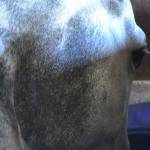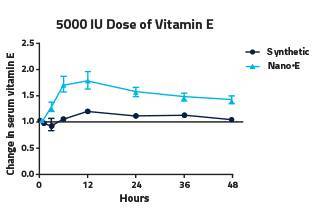How Is Natural-Source Vitamin E Superior to Synthetic Vitamin E for Horses?

Vitamin E can be obtained from natural or synthetic sources, but the chemical structure of each is different. The following studies were conducted to determine if synthetic and natural-source vitamin E have similar bioavailabilities when administered at equal IU doses and to determine if water-dispersible forms of vitamin E are more bioavailable than lipid-soluble forms.
In study 1, single 5,000-IU oral doses of three different forms of vitamin E were evaluated in eight Thoroughbreds during three one-week periods. The forms tested were synthetic vitamin E (dl-alpha-tocopheryl acetate) (SYN); natural-source vitamin E acetate (d-alpha-tocopheryl acetate) (ACT); and natural-source alcohol (d-alpha-tocopherol) (ACL). Baseline blood serum samples were collected immediately before dosing and at 3, 6, 9, 12, and 24 hours post-dosing. In this study, ACT and ALC had a significantly greater AUC than SUN. There was no significant difference in AUC between ACT and ALC. Relative to SYUN, the bioavailability of ACT and ALC equaled 197% and 252%, respectively.

Nano-E, a source of natural vitamin E, more effectively raises serum vitamin E levels when compared to synthetic vitamin E. Dose response equals multiple of 0 hr value which is represented as 1.
In study 2, three Thoroughbreds were used in a replicated 3 x 3 Latin square trial to assess the relative bioavailability of 5,000-IU oral doses of synthetic vitamin E (dl-alpha-tocopheryl acetate) (SYN); a micellized d-alpha-tocopherol; and a d-alpha-tocopherol (Nano-E®) that had been nanodispersed into liposomes. Baseline blood serum samples were collected immediately before dosing and at 3, 6, 9, 12, 24, 36, and 48 hours post-dosing. The micellized d-alpha-tocopherol and Nano-E® had a significantly greater AUC than SYN. There was no significant difference in AUC between the micellized d-alpha-tocopherol and Nano-E®. Relative to SYN, the bioavailability of the micellized d-alpha-tocopherol and Nano-E® equaled 559% and 613%, respectively. Nano-E® had significantly higher peak and maximal change from baseline values compared to SYN.
The results of these studies suggest that natural sources of vitamin E have a greater bioavailability than is accounted for in the current conversion factors of 1.36 and 1.49 used in the feed industry for natural acetate and alcohol, respectively. Nano-E®, a natural-source, water-dispersible form of vitamin E, was five to six times more bioavailable than synthetic vitamin E acetate, and a 5,000-IU dose more than doubled serum vitamin E levels within 12 hours.
Learn more about Nano-E® here.
This report of KER’s research was published in Proceedings of the Australasian Equine Science Symposium.
The full-length research report is available on Equinews.com. Read it now: Form of Alpha-Tocopherol Affects Vitamin E Bioavailability in Thoroughbred Horses.








